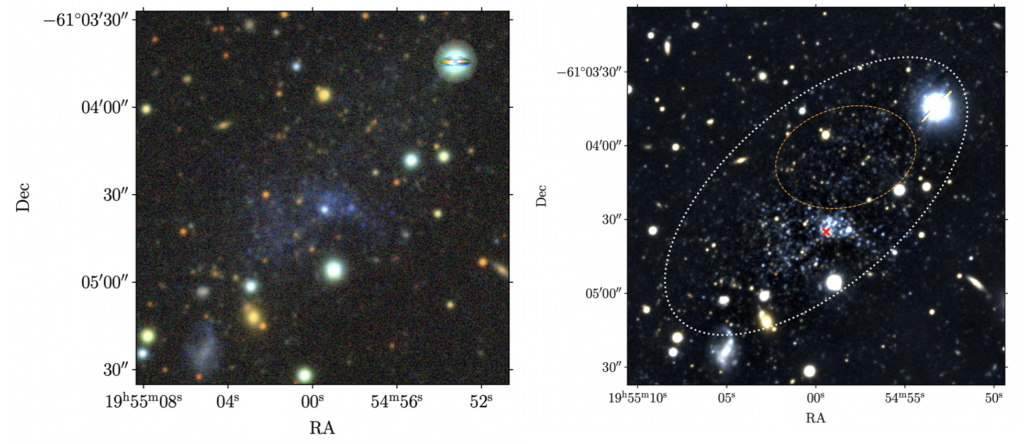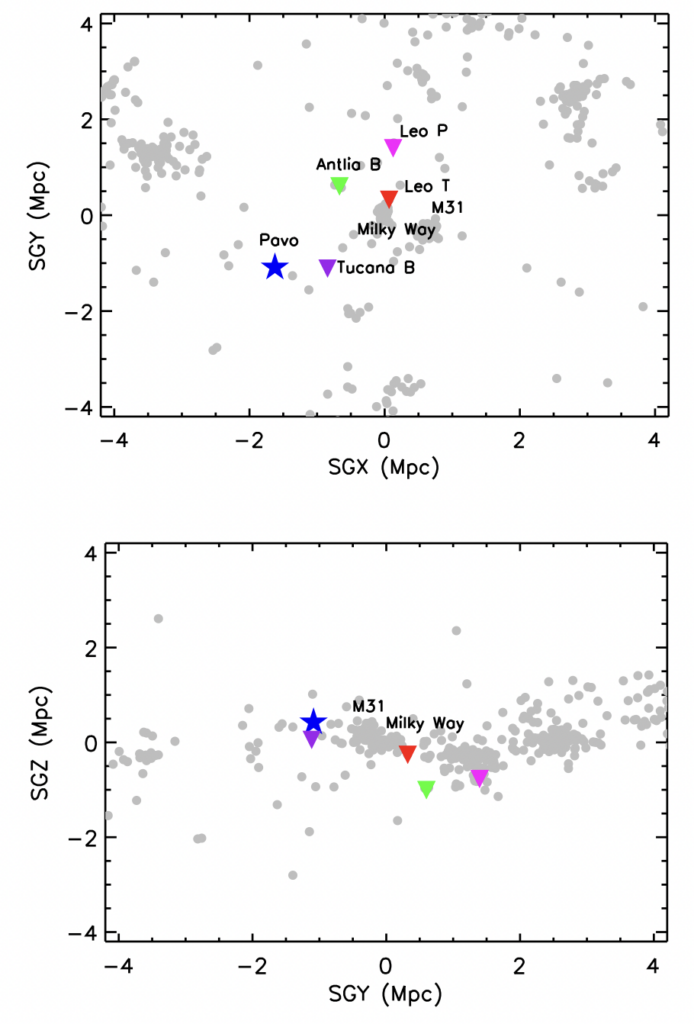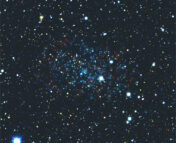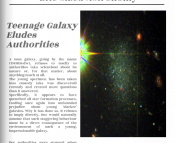Title: Pavo: Discovery of a star-forming dwarf galaxy just outside the Local Group
Authors: Michael G. Jones, Burcin Mutlu-Pakdil, David J. Sand, Richard Donnerstein, Denija Crnojevic, Paul Bennet, Catherine E. Fielder, Ananthan Karunakaran, Kristine Spekkens, Jay Strader, Ryan Urquhart, Dennis Zaritsky
First Author’s Institution: Steward Observatory, University of Arizona
Status: Accepted to ApJL, available on arXiv
Small but Mighty
When it comes to understanding the history of the universe, dwarf galaxies are little but mighty. They provide insight into what galaxies might have looked like in the early universe, are excellent laboratories for studying how star formation is affected by the exchange of gas with galactic neighbors, and have puzzled astronomers for decades because of the tension between observations and predictions of the number of dwarf galaxies in our galactic neighborhood.
Dwarf galaxies played an important role in the early universe — their stars helped drive the Epoch of Reionization, in which light from the first generation of stars ionized neutral hydrogen gas across the Universe. But as their hydrogen gas was heated in reionization, star formation in some small dwarf galaxies was snuffed out because cold, dense star-forming clouds evaporated or became too hot. How small is small enough to be quenched by reionization?
That’s a tricky question to answer, because many dwarf galaxies are in close proximity to other galaxies, so even if their star formation was shut down by reionization, it could get restarted by inflows of gas from a neighbor. To answer this question, we have to find dwarf galaxies that are relatively isolated. Large area surveys have allowed researchers to discover many ultra-faint and low-mass galaxies through their resolved stellar populations – meaning that the stars in these galaxies can be individually distinguished. To find more isolated dwarfs though, we may need to look further afield outside of our galaxy’s neighborhood (the Local Group) whose stellar populations are only partially resolved. Today’s authors comb through existing surveys using a machine learning algorithm, and discover a small dwarf galaxy on the fringe of the Local Group!
Taking a Closer Look at a Distant Neighbor
The authors use images from the Dark Energy Camera Legacy Survey (DECaLS), the Mayall z-band Legacy Survey (MzLS), and the Beijing Arizona Sky Survey (BASS) surveys to look for low mass, isolated dwarf galaxies. These surveys cover thousands of square degrees of the sky, which is a large area! (For reference, the moon is about a half a degree across.) To sort through all this data, the authors train a convolutional neural network classifier called SMUDGes based on good and bad examples of dwarf galaxy candidates from a relatively small (150 square degree) region of the sky. After selecting galaxies with SMUDGes, images of galaxy candidates were categorized by volunteers at Zooniverse, with a subset being classified as nearby, low mass, and with partially resolved stars. From this winnowed down group, today’s authors highlight a particularly striking and lonesome galaxy: Pavo (named after the constellation where it resides in the sky).
After its discovery, the authors obtained more images of Pavo using the Inamori-Magellan Areal Camera & Spectrograph (IMACS) to get a better look at its stars. In addition, they use UV images from the Swift Observatory to measure its star formation rate (since UV emission traces younger stars that have recently formed) and H-alpha images from the Southern Astrophysical Research Telescope to look for star-forming regions (since H-alpha is emitted by excited hydrogen gas that surrounds massive young stars).
Learning from the stars

What do Pavo’s stars tell us about its history? In the IMACS image of Pavo (right part of Figure 1), produced by adding g and r filters, many of its stars can be individually seen. Pavo appeared blue in the DECaLS imaging (left part of Figure 1), and this population of younger stars, which emit in bluer wavelengths due to their hot temperatures, is visible in the IMACS image as well. However, this new image also reveals an older, redder group of stars – many generations of stars coexist in this galaxy! With its young blue stars, it appears that Pavo survived reionization – but its star formation history over the past ten million years or so is less clear. The H-Alpha observations show no signs of star-forming regions in Pavo. Are there any very young stars in Pavo? To produce regions that are bright in H-Alpha, an O type star (which is extremely massive) would ionize the surrounding hydrogen gas. There could be very young stars in Pavo that aren’t massive enough to ionize this gas, but based on Pavo’s UV star formation rate, it’s likely that star formation has ceased over the past ten million years.

Pavo’s stars can also tell us how far away the galaxy is. For this, we have to look at what happens to stars further in their lifetime. When stars like the Sun run out of enough hydrogen in their core, they start burning hydrogen in a shell that surrounds a core made mostly of helium. Once the temperature of the helium core increases enough, it will ignite in a rapid chain reaction called a helium flash – stars in this phase of life are at the tip of the red giant branch (RGB) on the Hertzsprung-Russell diagram. The tip of the RGB (TRGB) is a “standard candle” since the brightness of a helium flash is always the same. This allows us to determine the distance to these stars (and the galaxy they belong to).
Using this method, the authors find that Pavo is about two million parsecs away from the Milky Way (roughly three times the distance to the Andromeda galaxy). Figure 2 shows the location of Pavo relative to the Milky Way, Andromeda (M31) and several dwarf galaxies in the Local Group. The bottom panel of Figure 2 shows that Pavo resides in the “Local Sheet”, a flattened group of galaxies, while the top panel illustrates it’s in a pretty isolated spot. In fact, its closest neighbor is 600 thousand parsecs away, making it one of the most isolated low mass dwarf galaxies yet discovered!
The authors note that future, higher resolution space-based observations will allow for a more detailed view of its stellar populations, which will give greater insight into Pavo’s history of star formation. Since Pavo has likely never had any significant encounters with a more massive galaxy neighbor, it’s an interesting test case for how star formation occurs in the lowest mass galaxies. With many upcoming large area surveys with instruments like the Roman Space Telescope and the Vera C. Rubin Observatory, many more systems like Pavo are expected to be discovered soon, including even lower mass, isolated galaxies that may have been quenched from reionization. Using machine learning to find dwarf galaxies who are too distant and faint for their stellar populations to be fully resolved will extend the distances where these galaxies can be found. We might soon discover many twins of Pavo, even if Pavo is still all alone at the edge of the Local Group!
Edited by Lina Kimmig
Featured image credit: Adapted from Figure 1 of today’s paper




